Updated: 26-Feb-2020
The "Burlat Frères" company from Lyon constructed rotary car engines: they exhibited them at the 1907 and 1908 Paris Air Show.
-The collaboration with "Societé de Camions et Bus" (with rotary engines as well) led to a four-cylinder bi-rotary cross-engine.
-Its power output was 40 CV and its weight 115 Kgs.

"Burlat real"
-It had a cylinder diameter of 95 mm and a 120 mm stroke.
-The crankshaft, instead of being fixed like in Gnome engines, spinned twice the cylinder speed according to La Hire theorem.
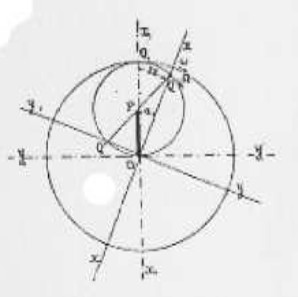
"La Hire theorem"

"Burlat principles"
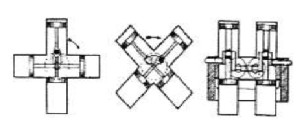
"Operation"
-Burlat also made a 70 CV 8-cylinder, and a 140 CV 16-cylinder.
-We have received an outline for the Burlat double rotary. It consists of two coupled four-cylinder radial engines where each coupled engine has its own carburetor,
-It is a rotary engine. While the crankshaft rotates at 2,600 rpm the crankcase does it at 1,200 rpm delivering 60 CV.
-The construction of a 16-cylinder engine that gave 120 CV is mentioned.
-Because of its difficult construction. it has not been recognized as practical value.
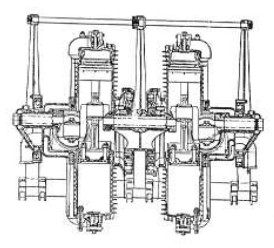
"Burlat 8-cylinder engine"
From Appendix 6: In 1904, Lyon engineer Antoine Burlat founded the "Société des Moteurs Burlat" car company in Villeurbanne near Lyon.
-In addition to the engines and illustrations in the main text, we include others, which are obtained in a short summary of the brand.
-For their use in aviation the formula was the same. They were air-cooled, bi-rotary X-engines, so the crankshaft was rotating in the contrary direction of the cylinders.
-The 35/40 CV, which is from 1910, is shown below, fitted within a frame that at the same time is protecting it.
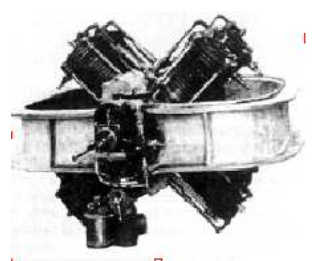
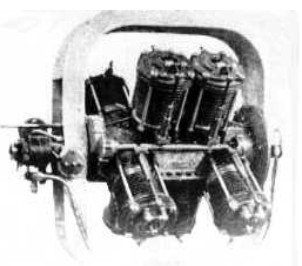
"35/40 CV views"
-In these illustrations we can see more details, especially for the cylinders. These days the name of the company becomes “Société des Moteurs Rotatifs Burlat”. This company would end its active life in 1914.
-At the 1912 Paris Air Show, Burlat presented the 75 CV engine with a bi-rotary system that was based on the Lahire theorem (see), sometimes La Hire.
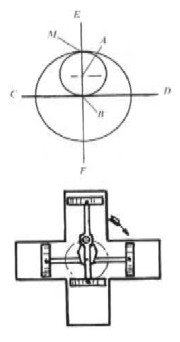
"Burlat, LaHire"
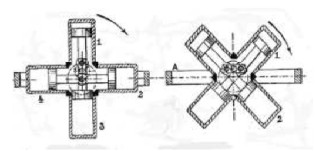
"Burlat"
-And this is how we see it in the cross section below.
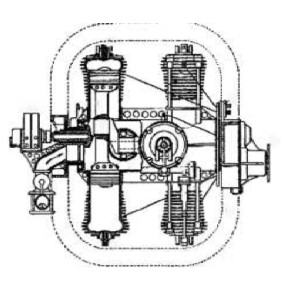
"Burlat -see offset crankcase-"
-Now we see another Burlat example, but with 75 CV. It is also fitted within a chassis for better protection.
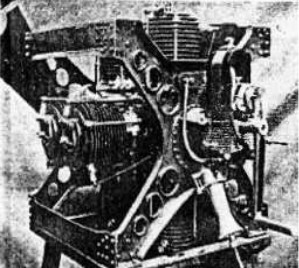
"Burlat 75 CV within its chassis"
-Another Burlat with more power output is the 140 CV, which was presented at the Paris Air Show in December 1912.
-This was a twin engine made from two eight-cylinders, so it had 16 cylinders.
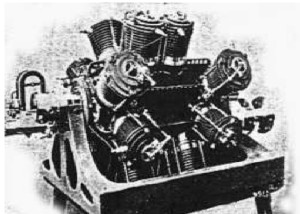
"The most complex 16-cylinder"
-Compared to a simpler engine like the 65 CV version below.
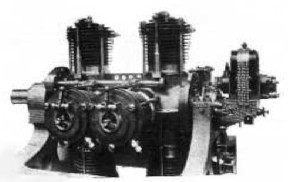
"Burlat 65 CV"
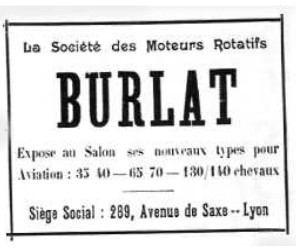
"Ad from that time"
From appendix 9: See main text. We now add a group of cylinders and a face cam. See the follower's displacement through the track.

"Burlat engine details"
-Here we include new and better images of these engines. First the 8-cylinder 60 hp rotary.
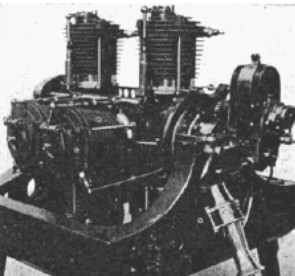
"Burlat 8-cylinder"
-Below, we show another picture of the 16-cylinder, which is a double 8-cylinder.
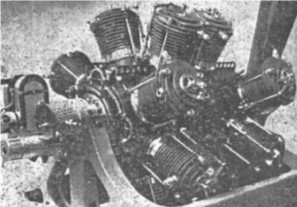
"Burlat 16-cylinder with propeller"
From Appendix 10: Below we show a new series of Burlat photos. Starting with its logo belonging to the denomination "MRB" (Moteur Rotatif Burlat).
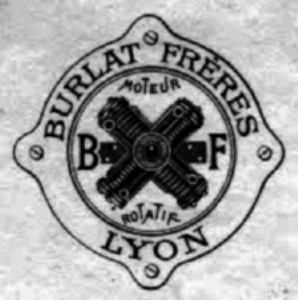
"Burlat logo"
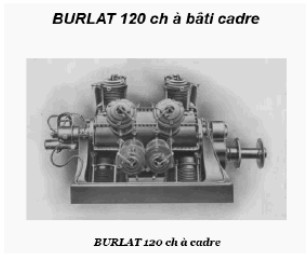
"Photo from a Burlat leaflet"
-The motor of the previous illustration is a 120-140 CV, but they also made smaller ones that gave 30-40, or 65-70 hp.
-These photographs are taken from a Burlat catalog.
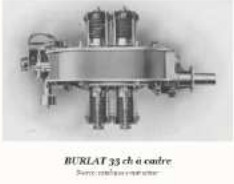
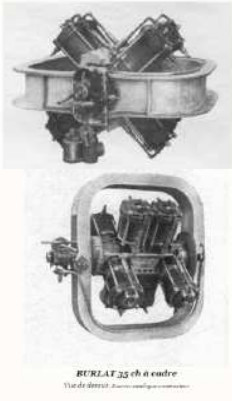

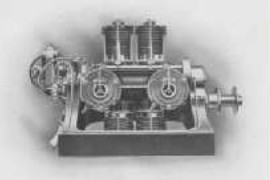
"The 60-70 CV on framework" (from the Catalog)

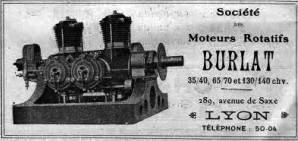
“Ad for the previous engine”
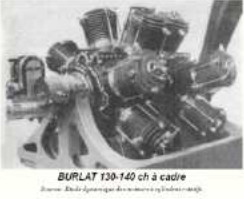

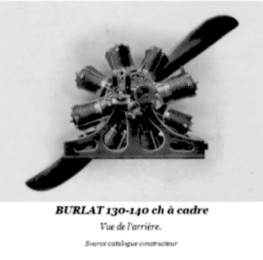
"Three Burlat 130-140 hp views" (from Catalog)
Engines of BURLAT
Model: 16 cils. rotativo, 140 CV
Arquitecture: 16-cylinder Rotary
Cooling:
Total Displacement:
Bore / Stroke:
Power: 140 CV @ rpm
Weight:
The 16-cylinder Burlat rotary consisted of two coupled 8-cylinders.

"Burlat 16-cylinder with propeller"
Model: 4 cils. rotativo 35/40 CV
Arquitecture: 4-cylinder Rotary
Cooling:
Total Displacement:
Bore / Stroke: 95 x 120 mm
Power: 40 CV @ rpm
Weight: 115 Kg
A four-cylinder bi-rotary cross-engine.

"Burlat 35/40 CV"
Model: 8 cils, rotativo 75 CV
Arquitecture: 8-cylinder Rotary
Cooling:
Total Displacement:
Bore / Stroke:
Power: 75 CV @ rpm
Weight:

"Burlat 75 CV inside its chassis"
Model: 8 cils. rotativo 65/70 CV
Arquitecture: 8-cylinder Rotary
Cooling: Air
Total Displacement:
Bore / Stroke:
Power: 65 / 70 CV @ 1200 / 2600 rpm
Weight:
Burlat double rotary. It consists of two coupled four-cylinder radial engines where each coupled engine has its own carburetor,
It is a rotary engine. While the crankshaft rotates at 2600 rpm the crankcase does it at 1200 rpm.

"Burlat, 65 CV"


